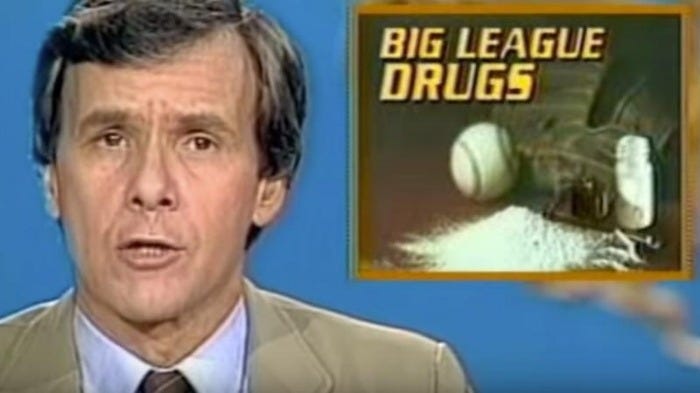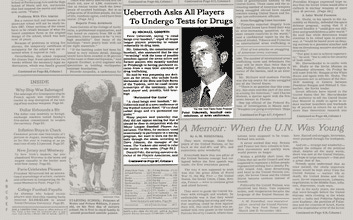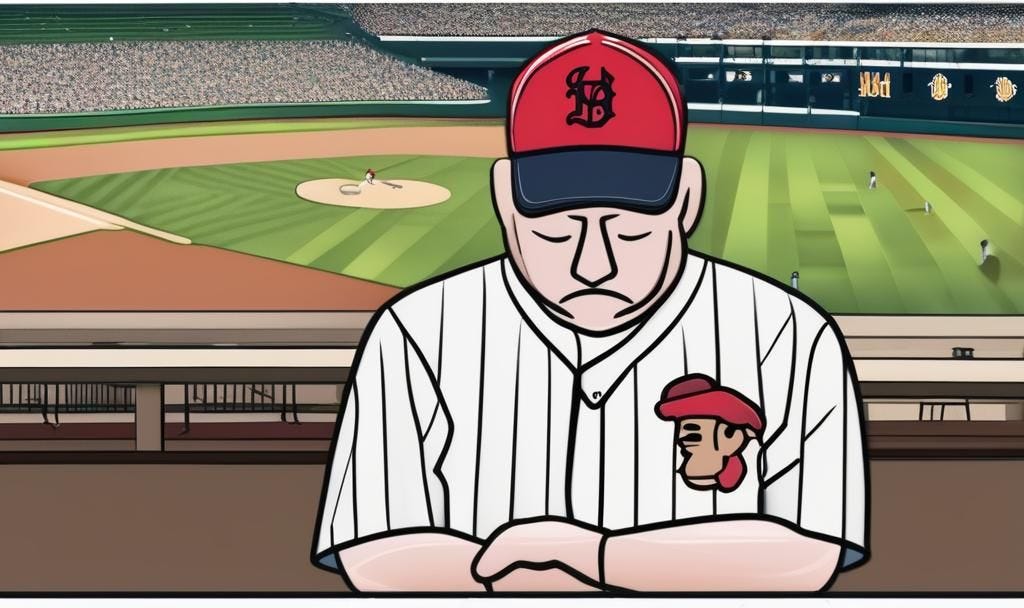Foul Play Files: The 1985 MLB Cocaine Scandal
In the mid-1980s, a drug scandal rocked Major League Baseball. The investigation had wild testimonies and verdicts that impacted the league’s reputation. Let’s explore all the details.
In the mid-1980s, a drug scandal rocked Major League Baseball. The case centered around several players from multiple teams, including some future Hall of Famers, who were found to be using cocaine and even helping distribute drugs to other clubs.
The investigation had wild testimonies and verdicts that impacted the league’s reputation. Let’s explore all the details on today’s episode.
1980’s America: A Cocaine Paradise

Cocaine use in America didn’t start in the 1980’s. Its usage dates back to the late 1800s when many used it as a beneficial medical treatment. American doctors would commonly use cocaine as a local anesthetic for minor surgeries, and would even prescribe it for chronic pain conditions and depression.
Cocaine was even a common ingredient in many over-the-counter medicines and tonics. For example, early versions of Coca-Cola contained coca leaf extract until 1904.
Wealthy elites mostly preferred the drug up until the 1970s. If you used coke, you had family money to burn. But in the 1970s there was a surge in supply thanks to drug cartels in Central and South America, which made the drug cheap enough to buy for middle-class salaries.
This group included professional baseball players, who still, for the most part, were not making more money than an average white-collar worker.
By 1985, an estimated 5.7 million Americans reported using cocaine annually. Major League Baseball got caught up in this societal craze, too.
Early Warning Signs of Cocaine Use in Baseball
In 1979, the Pittsburgh Pirates, a team that would later become central to baseball’s cocaine scandal, won the World Series.
During that season, Pittsburgh Pirates pitcher Rod Scurry had developed a severe cocaine addiction. That addiction escalated into a destructive incident in a San Diego hotel room. After that story hit the news waves, the Pirates manager publicly urged Scurry to seek help.
He became the early warning sign that cocaine use had made its way into MLB clubhouses.
In 1983, popular St. Louis Cardinals outfielder outfielder Lonnie Smith announced he was entering a drug rehab facility for cocaine addiction.
In that same season, a major cocaine dealer named Mark Liebl was arrested. His investigation uncovered that he was dealing drugs directly to players on the Kansas City Royals roster. Liebl's arrest led to the imprisonment of four Royals players: Willie Wilson, Vida Blue, Willie Aikens, and Jerry Martin.
In February of 1985, Oakland A's pitcher Mike Norris was pulled over and arrested for cocaine possession. The high-profile stories of multiple players using cocaine forced Major League Baseball to take public action.
The MLB’s Initial Response
In that same month that Mike Norris was arrested, league commissioner Peter Ueberroth announced mandatory drug testing for minor league players AND MLB owners, executives, managers, and umpires.
However, he faced pushback from the players' union regarding random drug testing for MLB players.
The MLB's handling of the cocaine problem drew widespread criticism from fans and the media. Some news reports argued that MLB executives and team owners must have known about the widespread cocaine use among players, yet chose to ignore it to protect profits.
The Cocaine Scandal Grows to Epic Proportions

Remember Rod Scurry, the Pirates player with the public hotel room destruction incident? He had ended up accepting his manager’s suggestion to get some help, and entered a drug rehab program.
While in rehab, Scurry was approached by FBI agents wanting to understand the extent of the drug problem within Major League Baseball.
Scurry seemed motivated to turn his life around (and probably strike a deal to avoid any fines or prison time) and gave the FBI names of individuals supplying cocaine to his own team and others around the league.
An investigation kicked off, which led to a grand jury indictment of cocaine dealers named Curtis Strong, Robert McCue, and five others.
The story of illegal cocaine flooding America’s game was now on every newspaper’s front page in America.
The Pittsburgh Drug Trials Begin
In September of 1985, a public trial began that brought baseball’s cocaine problem to its full, ugly light. Multiple MLB players were called on to testify, in the middle of an ongoing season. It became THE focus of baseball fans and most of the American news media.
The trial hearings centered around drug distribution networks inside Major League Baseball, particularly within the Pittsburgh Pirates organization. Even the team's mascot, the Pirate Parrot, was implicated in buying cocaine through these dealers.
The hearings also exposed the widespread use of amphetamines, or "greenies" by MLB players. These drugs were used to increase alertness and energy during games.
Players like Dale Berra, son of New York Yankee great Yogi Berra, testified under oath that amphetamines were common among most players and that he even received them from veteran players like future Hall of Famers Willie Mays and Willie Stargell and 4-time National League Batting Champion Bill Madlock.
Startling Testimonies from MLB Players
Keith Hernandez, the National League MVP in 1979, also had to take the stand to testify. During his testimony, he estimated that around 40% of all MLB players were using cocaine in the early 1980s. His comments touched off a huge storm of criticism, which Hernandez tried to backtrack on by later saying he may have been "grossly wrong" in his assessment.
Tim Raines, a speedy outfielder for the Montreal Expos, admitted in testimony to keeping cocaine in his uniform pocket and snorting during games.
John Milner, a retired player who had spent time with the Pittsburgh Pirates and New York Mets, testified that his former teammate Willie Mays kept "red juice" - a liquid containing amphetamines - in his locker, although he never witnessed Mays using it.
MLB players Dave Parker, Enos Cabell, and Jeff Leonard all testified about their involvement with Curtis Strong, detailing how they would contact him to arrange meetings in hotel rooms to obtain cocaine.
Fallout From the Drug Trials
While the hearings brought to light the amount of cocaine use by MLB players, the only people on trial were the dealers under investigation. Trials verdicts included the following:
Robert McCue is sentenced to 10 years in prison for cocaine distribution.
Curtis Strong is sentenced to four to twelve years in prison.
After verdicts were delivered, MLB Commissioner Peter Ueberroth publicly guaranteed the elimination of drugs from professional baseball.
In the coming weeks, Ueberroth suspended 21 MLB players for their involvement in the drug scandal. All those suspensions ended up being lessened, as players were allowed to end their suspensions in exchange for fines, community service, and agreements to undergo random drug testing.
How the 1985 Cocaine Scandal Affected Baseball’s Future
The drug scandals that led to the 1985 Pittsburgh drug trials indeed had a lasting impact on Major League Baseball, including:
Damage to the Game’s ‘Purity’
The trials brought the issue of drug use in baseball into the national spotlight. Testimony from all-star players and mentions of usage by future Hall of Famers shattered whatever illusion Americans had of a clean sport.
This public exposure damaged the reputation of MLB and eroded public trust in the integrity of the game that baseball has so often touted throughout its history.
The Beginnings of Player Accountability
The scandal forced MLB to take action to address its drug problem. Mandatory drug testing for minor league players and MLB personnel was a first step. The MLB pushed for its own players to receive the same, and even tried to expand drug testing to Latin American winter leagues.
However, the players' union resisted any random drug testing for MLB players. It wasn’t until 2002 that players and owners announced a collective bargaining agreement that included a urine test for banned steroids.
Unhealed Wounds That Resurfaced in the Steroid Era
Despite Ueberroth's pronouncements of a "drug-free" baseball after the trials, skepticism remained among fans and the media (rightfully so.)
Many questioned how such widespread drug use could have gone unnoticed by team management and league officials. The failure to effectively address the root causes of drug use and the continued debate over amphetamine use, which was not banned at the time, arguably paved the way for the steroid era that would plague MLB in the 1990s and 2000s.
The parallels between the cocaine scandal of the 1980s and the later steroid scandal are striking, with both eras embracing a culture of denial, a reluctance to expand comprehensive drug testing, and ineffective responses from MLB leadership.
Thanks for Supporting the Show!
If you haven’t yet, would you consider becoming a paid subscriber?
You get:
The ad-free version of our weekly main show 'Rounders' a whole DAY EARLIER.
A sneak peek at our secret list of upcoming episodes.
A chance to share your thoughts, which I might just read out in the episode.
Exclusive chats, events, and more fun stuff only for our members.
And if you're feeling extra awesome, join our 'Starting Nine' crew. Help shape the show, pick episode topics, and even get a shoutout as a producer.
Let's make 'Rounders' the top baseball history show together!










